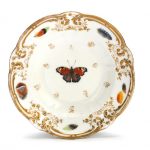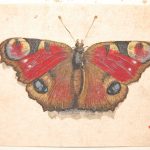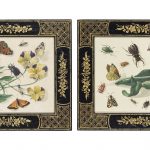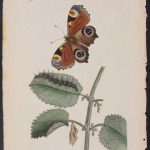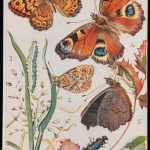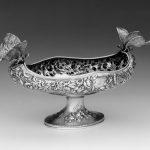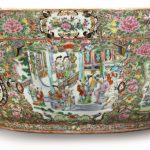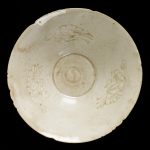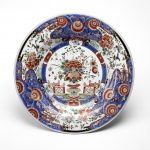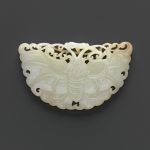Peacock butterflies. The Peacock Butterfly or Aglais io, is a colourful butterfly, found in Europe and temperate Asia as far east as Japan. It was formerly classified as the only member of the genus Inachis (the name is derived from Greek mythology, meaning Io, the daughter of Inachus). It should not be confused or classified with the “American peacocks” in the genus Anartia; these are not close relatives of the Eurasian species. The peacock butterfly is resident in much of its range, often wintering in buildings or trees. It therefore often appears quite early in spring. The peacock butterfly has figured in research in which the role of eyespots as an anti-predator mechanism has been investigated. The peacock is expanding its range and is not known to be threatened.
The peacock can be found in woods, fields, meadows, pastures, parks, and gardens, from lowlands up to 2,500 metres (8,200 ft) elevation. It is a relatively common butterfly, seen in many European parks and gardens. The peacock male exhibits territorial behaviour, in many cases territories being selected en route of the females to oviposition sites. Reference: Wikipedia
A very unusual Nantgarw bowl, circa 1818-20 Of shallow form with C-scroll moulding picked out in gold, painted in London with a central peacock butterfly surrounded by scattered gilt sprigs, the border panels with brightly coloured feathers, 20.5cm diam, impressed NANT-GARW CW FOOTNOTES The peacock butterfly is accurately painted and must have been copied from a source print, or perhaps directly from life. Accurate representations of butterflies are only rarely found on British porcelain, mostly on Derby. Compare with the Nantgarw shell dish locally painted with butterflies by Thomas Pardoe with little attempt at realism and illustrated by W D John, Nantgarw Porcelain Album (1975), Illustration 78
Sold for £ 1,250 inc. premium at Bonhams in 2018
A Peacock Butterfly (Vanessa io), one of 179 drawings from the 1637 album Watercolour and bodycolour, heightened with white (partly oxidised) 1600-1620 (fl.circa)
Reference: © The Trustees of the British Museum
English School, Early 20th Century Trompe l’oeil of a primula, butterfly peacock and other insects; and Trompe l’oeil of a pansy, grasshopper and other insects signed with initials ‘G.O’ (lower right) pencil and watercolour on paper 7 x 9 in. (17.7 x 22.8 cm.) (2)a pair
Sold for GBP 1,000 at Christies in 2016
Shaw & Nodder – Peacock Butterfly
The Naturalist’s Miscellany was a monumental 24-volume work, known for its wide range of birds, reptiles, insects, quadrupeds, sea life, and botanicals. These prints are highly sought after by collectors for their extremely decorative and whimsical nature. George Shaw authored the work, providing details for the over 1000 species described therein. Fredrick Nodder was the engraver for most of the work. After his death in 1800, however, his son took over the position. This particular engraving was published between 1789 and 1793.
Sold for $110 at Trillium Antique Prints & Rare Books in 2019
Wall butterfly in flight; Wall butterfly at rest; Caterpillar of Wall butterfly; Peacock butterfly in flight; Peacock butterfly at rest; Caterpillar of Peacock butterfly. English about 1930 Publisher Raphael Tuck & Sons (English, 1886–1960)
Reference: Museum of Fine Arts Boston
Footed bowl 1880–90 Samuel Kirk & Son (active 1846–1861, 1868–1896), Samuel Kirk (American, 1793–1872), Henry Child Kirk, Sr. (American, 1827–1914), Henry Child Kirk Jr. (American, joined firm in 1890)
The shallow, oval, raised bowl of the compote has an undulating rim with a rounded applied band and sits on a spool-type pedestal with a wide oval foot. Large butterflies of indeterminate species (possibly a swallowtail butterfly, family Papilionidae), with stamped details, perch upon the ends of the bowl. A dense band of repousséd and chased floral decoration circles the bowl, under the rim. Clusters of naturalistic flowers embellish the front and back of the engraved and punched ground of the elliptical foot with applied foot ring. This footed bowl still displays the deep relief characteristic of the Rococo-revival style, as seen in the encircling naturalistic band of flowers. However, the graphic outlines and flat interior markings of the butterfly’s wings seem to relate it to the newer, flatter forms and more stylized design popular during the last quarter of the nineteenth century. The sinuous line of the rim and elongated body suggest a natural pool of water that has attracted the two insects and may reflect an affinity for the Japanese aesthetic in vogue at the time. This text has been adapted from “Silver of the Americas, 1600-2000,” edited by Jeannine Falino and Gerald W.R. Ward, published in 2008 by the MFA. Complete references can be found in that publication.
Reference: Museum of Fine Arts Boston
A RARE AND MASSIVE CHINESE CANTON FAMILLE-ROSE ‘ROMANCE OF THE THREE KINGDOMS’ BOWL, 19TH CENTURY sturdily potted set on a straight short foot rising up to a slightly flaring rim, the exterior finely decorated allover with blossoms, fruits and butterflies, with two circular reserves painted with peonies issuing from rockwork, and four shaped reserve panels decorated with figures in garden pavilions, the interior painted with a continuous scene of characters from the Romance of the Three Kingdoms reserved on a bright yellow ground diameter 23 in.; 58.5 cm
Sold for 12,500 USD at Sothebys in 2019
Bowl of porcelain with decoration incised under a qingbai glaze. Conical with six notches in the rim. The inside is engraved with three butterflies, surrounding a central medallion containing a yin-yang symbol. Place of Origin Jingdezhen (made) Date 12th century (made)
Reference: © Victoria and Albert Museum

